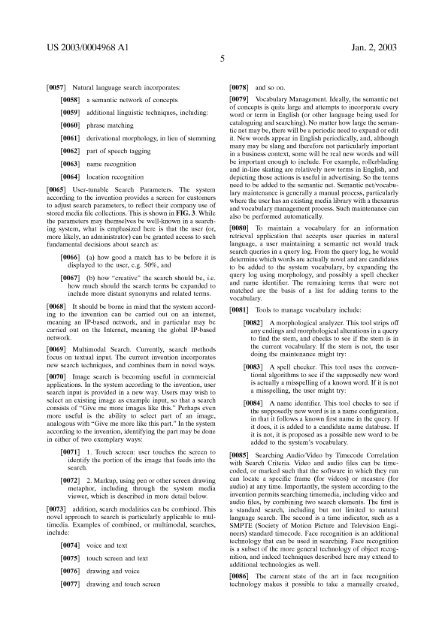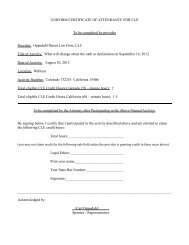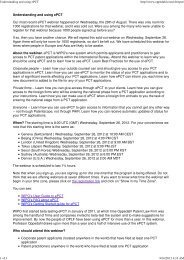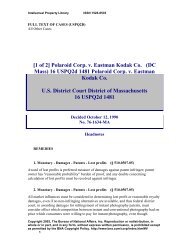Patent Application Publication (10) pub. NO.: US 2003/0004968 A1
Patent Application Publication (10) pub. NO.: US 2003/0004968 A1
Patent Application Publication (10) pub. NO.: US 2003/0004968 A1
You also want an ePaper? Increase the reach of your titles
YUMPU automatically turns print PDFs into web optimized ePapers that Google loves.
Jan. 2,<strong>2003</strong><br />
[0057] Natural language search incorporates:<br />
[0058] a semantic network of concepts<br />
[0059] additional linguistic techniques, including:<br />
[0060] phrase matching<br />
[0061] derivational morphology, in lieu of stemming<br />
[0062] part of speech tagging<br />
[0063] name recognition<br />
[0064] location recognition<br />
[0065] User-tunable Search Parameters. The system<br />
according to the invention provides a screen for customers<br />
to adjust search parameters, to reflect their company use of<br />
stored media file collections. This is shown in FIG. 3. While<br />
the parameters may themselves be well-known in a searching<br />
system, what is emphasized here is that the user (or,<br />
more likely, an administrator) can be granted access to such<br />
fundamental decisions about search as:<br />
[0066] (a) how good a match has to be before it is<br />
displayed to the user, e.g. 50%, and<br />
[0067] (b) how "creative" the search should be, i.e.<br />
how much should the search terms be expanded to<br />
include more distant synonyms and related terms.<br />
[0068] It should be borne in mind that the system according<br />
to the invention can be carried out on an internet,<br />
meaning an IP-based network, and in particular may be<br />
carried out on the Internet, meaning the global IP-based<br />
network.<br />
[0069] Multirnodal Search. Currently, search methods<br />
focus on textual input. The current invention incorporates<br />
new search techniques, and combines them in novel ways.<br />
[0070] Image search is becoming useful in commercial<br />
applications. In the system according to the invention, user<br />
search input is provided in a new way. Users may wish to<br />
select an existing image as example input, so that a search<br />
consists of "Give me more images like this." Perhaps even<br />
more useful is the ability to select part of an image,<br />
analogous with "Give me more like this part." In the system<br />
according to the invention, identifying the part may be done<br />
in either of two exemplary ways:<br />
[0071] 1. Touch screen: user touches the screen to<br />
identify the portion of the image that feeds into the<br />
search.<br />
[0072] 2. Markup, using pen or other screen drawing<br />
metaphor, including through the system media<br />
viewer, which is described in more detail below.<br />
[0073] addition, search modalities can be combined. This<br />
novel approach to search is particularly applicable to multimedia.<br />
Examples of combined, or multimodal, searches,<br />
include:<br />
[0074] voice and text<br />
[0075] touch screen and text<br />
[0076] drawing and voice<br />
[0077] drawing and touch screen<br />
[0078] and so on.<br />
[0079] Vocabulary Management. Ideally, the semantic net<br />
of concepts is quite large and attempts to incorporate every<br />
word or term in English (or other language being used for<br />
cataloguing and searching). No matter how large the semantic<br />
net may be, there will be a periodic need to expand or edit<br />
it. New words appear in English periodically, and, although<br />
many may be slang and therefore not particularly important<br />
in a business context, some will be real new words and will<br />
be important enough to include. For example, rollerblading<br />
and in-line skating are relatively new terms in English, and<br />
depicting those actions is useful in advertising. So the terms<br />
need to be added to the semantic net. Semantic netlvocabulary<br />
maintenance is generally a manual process, particularly<br />
where the user has an existing media library with a thesaurus<br />
and vocabulary management process. Such maintenance can<br />
also be performed automatically.<br />
[0080] To maintain a vocabulary for an information<br />
retrieval application that accepts user queries in natural<br />
language, a user maintaining a semantic net would track<br />
search queries in a query log. From the query log, he would<br />
determine which words are actually novel and are candidates<br />
to be added to the system vocabulary, by expanding the<br />
query log using morphology, and possibly a spell checker<br />
and name identifier. The remaining terms that were not<br />
matched are the basis of a list for adding terms to the<br />
vocabulary.<br />
[0081] Tools to manage vocabulary include:<br />
[0082] Amorphological analyzer. This tool strips off<br />
any endings and morphological alterations in a query<br />
to find the stem, and checks to see if the stem is in<br />
the current vocabulary. If the stem is not, the user<br />
doing the maintenance might try:<br />
[0083] A spell checker. This tool uses the conventional<br />
algorithms to see if the supposedly new word<br />
is actually a misspelling of a known word. If it is not<br />
a misspelling, the user might try:<br />
[0084] A name identifier. This tool checks to see if<br />
the supposedly new word is in a name configuration,<br />
in that it follows a known first name in the query. If<br />
it does, it is added to a candidate name database. If<br />
it is not, it is proposed as a possible new word to be<br />
added to the system's vocabulary.<br />
[0085] Searching AudioIVideo by Timecode Correlation<br />
with Search Criteria. Video and audio files can be timecoded,<br />
or marked such that the software in which they run<br />
can locate a specific frame (for videos) or measure (for<br />
audio) at any time. Importantly, the system according to the<br />
invention permits searching timemedia, including video and<br />
audio files, by combining two search elements. The first is<br />
a standard search, including but not limited to natural<br />
language search. The second is a time indicator, such as a<br />
SMPTE (Society of Motion Picture and Television Engineers)<br />
standard timecode. Face recognition is an additional<br />
technology that can be used in searching. Face recognition<br />
is a subset of the more general technology of object recognition,<br />
and indeed techniques described here may extend to<br />
additional technologies as well.<br />
[0086] The current state of the art in face recognition<br />
technology makes it possible to take a manually created,





